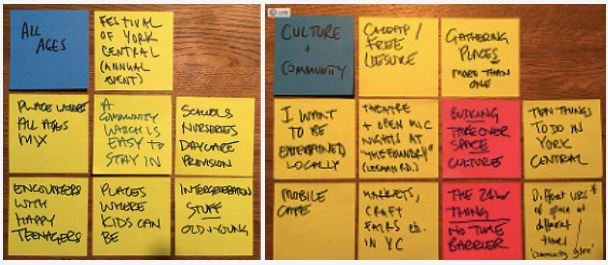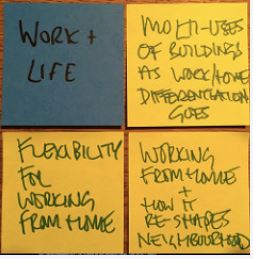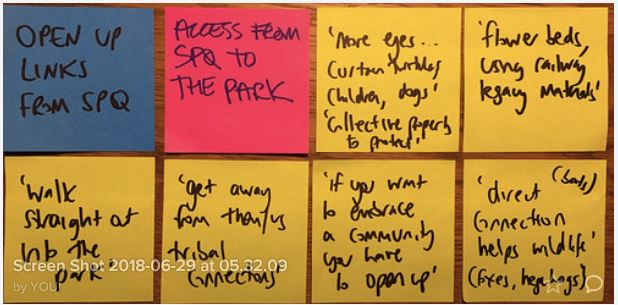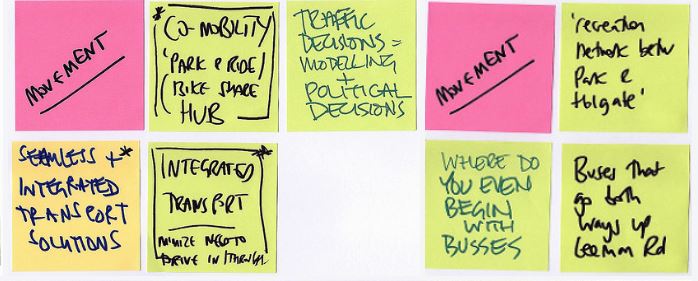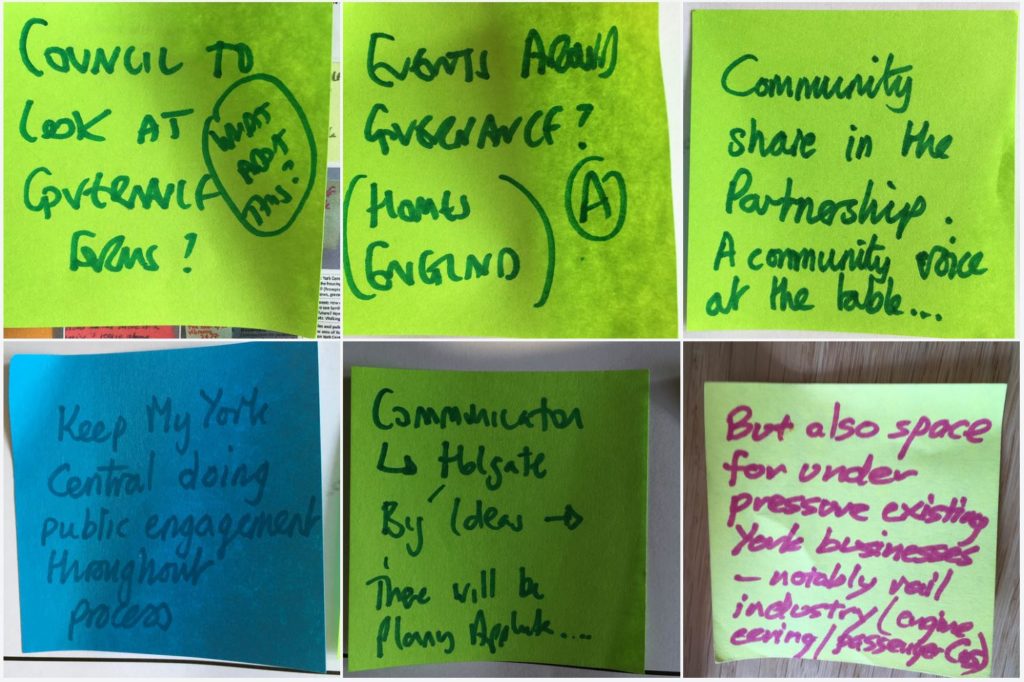Read more about how the Vision was produced and how it will be used, the Big Ideas summary of the Vision and the Principles for how York Central should develop from here. You can also read about how the My York Central work fits into the York Central Partnership’s next steps.
York Central as an integrated part of York
The development of York Central should bring to York elements which it needs to function better as a whole – it should “add something extra” and avoid harmful impact on existing elements of the city.
- Thinking City Wide: Looking at patterns of life and work within the city as a whole, and how these can be helped to function better. How will York Central fit into a broad process of improving our current housing provision? What do we do well economically and how can York Central strengthen the city’s economy and provide new opportunities? How can York Central’s transport infrastructure help to shape city-wide integration and improvements in sustainability? So, if a broad, seamless public transport network is required to give an appealing alternative to car ownership, should we be looking at a “Transport for York” umbrella body in order to shape and coordinate it?
- Combining different ways of knowing for change: Gathering and combining different information in more subtle ways. This means, for example, combining transport modelling with people’s own sense of their future behaviour. Yet this needs to be done not just as “knowing about: the current situation, it should be part of an active process which allows us to openly ask “what-if” and to consider change.
- Heritage as creativity and innovation: For the development to be informed by the past – of the city as a whole and of the site itself – but for this heritage significance (why the past matters in the present) to shape the development in creative and exciting ways.
A New Community on York Central
York Central is not just built form and space. There are examples in York where recent new developments are devoid of life and culture. The planning process needs to move beyond simply allocating land for development within a rational 3D structure. Placemaking needs to consider the narrative of the future place and to engage with people and society. This needs to be part of both the process and the physical form.
The process and form of development needs to provide for the lives that local people want to create there for themselves. Ongoing opportunities for them to shape and re-shape both the physical form (buildings and spaces) and the governance and financial structures (ownership and economy) need to be built into planning. The development should allow for how people want to live, not just reflect what we have done in recent decades.
- Inspiring ideas that open up possibilities: We should look for inspiration and practice elsewhere (for example Freiburg Vauban and Heidelberg Bahnstadt) for creative ways to deal with the management of car use and how this impacts on built form and the lives of inhabitants.
- Creating a community to bring the York Central community into being: We should be prepared to question accepted wisdom in respect of what brings value and marketability to development and should give consideration to the process of “buying in” to a type of community (in the way it has worked at Derwenthorpe). So, the basis for decision-making on car use/ownership should move from whether we dare deviate from the status quo (“most people have cars, so we design residential areas for cars since moving away from this would result in resistance”) towards consideration of alternative possibilities (“there must be lots of people for whom a car-free neighbourhood this close to the centre would command higher house prices”).
- Community-Led Approaches to Development: We should ensure routes for a wide variety of tenures and built form, through community-led homes, investigation of CLT models and other innovative routes. This process should also investigate long-term affordability and how this can be ensured.
- Positive benefits of high density through co-design: We should explore a range of models for family housing which go well beyond “a house with a garden” and look at the benefits of higher density and high-quality shared facilities. One comment was that downsizing to a flat in York Central would only be a possibility if it was very, very nice. So, people considering downsizing or moving to York Central should be involved in briefing and designing for that quality.
- Real and long term affordability: Affordability was a key issue during the community engagement process. Many people question the official definition of ‘affordable’ and called for greater ambitions in targets. York Central may not be able to “cure” York’s housing affordability problem, but is can demonstrate a methodology to start to address it.
- Public space which serves purposes: Home extends beyond the front door, and public space must be thought of as a key shaping tool in creating neighbourhoods, both spatially and in terms of social value. Public space must balance being truly public, with encouraging “ownership” by neighbours and users. There should be a continuum of types of space from playstreets to hard-surfaced urban shared space, gardens and parkland to wilder areas which encourage wildlife. Public space does not, importantly, all have to be at ground level.
Mixed and Thriving York Central
Affordability (of housing and space for commerce) should facilitate the growth of a mixed community, one where a local economy can thrive with links to the city as a whole.
- Mixed uses for a vibrant York Central: The need to zone commercial development away from housing was questioned and there was much discussion about whether a vibrant urban area needs mixed development and mixed uses. One quote was to “think 3D” – suggesting there might be benefits in having shops, social and commercial at ground level, offices at first floor and flats above to avoid the ‘ghost town’ effect and drive life in the public realm.
- Living + Working: We should question the need to zone or separate living and working Many small-ish creative businesses are both good neighbours to each other (as they often collaborate) and also good neighbours to other uses – including residential – as they create little nuisance. In fact there were benefits in having the kind of activity throughout the day and night that happens when work and homes are linked.
- Ways to contribute beyond work: Many people the future will simply not have jobs and they will be looking for creative ways of spending time and contributing and the design of the city should facilitate this, again pointing towards a mixed environment rather than one where work and homes are strictly zoned. There could be exciting possibilities for older residents wishing to have the option of inclusion within economic life, with the option to “invest” capital or time (or both) in neighbourhood economic activity.
- Graduates need affordable housing too: Keeping graduates is seen as crucial to growing York’s own talent. Without affordable places to both live and work, graduates will be unable to afford to take necessary business risks, and there will be too great a hurdle to jump in terms of getting starts ups happening. Affordable housing is not just a “housing” issue, but has an impact on economic activity.
The new community on York Central will be dynamic. From the simple fact of long-term development (a scheme which may take 20 years of more to complete) through to uncertainties about future trends in transport or employment, the process and physical form should “leave open doors” for different narratives and opportunities. So, for example:-
- Open Source Planning: A popular idea from David Rudlin’s talk on Grow Your Own Garden City was open source planning where a planning authority could pre-approve a variety of possible uses for people’s homes so they could turn them easily into small scale workspaces (open a hairdresser / set up an office).
- Neighbourhood Planning?: This is an issue which leads immediately to consideration of Neighbourhood Planning – what will be the status of York Central, and how will neighbourhood planning issues be dealt with as the community develops?
Learning and Working on York Central
Through the public engagement process it became clear that the nature of York’s educational and commercial infrastructure – with two universities and a hugely successful creative industry network – offered opportunities to consciously build new physical and organisational structures which would drive a new phase of economic and cultural development. This would be a high-density mixed development within walking distance of the station (and sufficiently compact to be largely walkable within) where people could live and work.
- Build for local business growth: It was also clear that there is a need both for provision for new businesses (supported shared space or incubator provision) and medium-sized growing businesses (10-12+ staff) in order for existing networks of interdependence to develop and grow.
- Large employers – but not as a primary driver: This does not rule out new larger employers moving in to York Central, but it suggests that these incomers should not be the primary drivers in terms of the shaping of development.
Another issue which has been highlighted by the community engagement process is that of drawing creative contributions (whether formal or informal, paid or unpaid) together.
A Social Contract for York Central: Spreading benefits, underpinned by human rights and creatively addressing inequalities
York Central should build upon York’s tradition of pioneering development (with New Earswick, radical 1940’s housing and JRHT’s Derwenthorpe) to ensure a new community which addresses human rights and inequalities. Processes of development should ensure wherever possible that houses become homes rather than investments. Affordable public transport should ensure that access across the city is available to all, and as far as is possible at all times. Creative approaches could be developed to enable intergeneration ‘circular economy’ exchanges of resources of time, expertise and capital.
- A “Social Contract” to spread benefit: Careful consideration of the process of development in relation to neighbouring communities and implementation of a “social contract” which allows existing communities to benefit from, and contribute to, York Central itself. For example can community infrastructure be located where the development meets existing communities – or even within those existing communities – to forge links and ensure a fair distribution of benefits of investment? How might community-led development approaches enable people to share time, expertise and financial resources to open up shared benefit.
- Prioritise pedestrians and cycle users: Transport infrastructure should reflect the agreed hierarchy of priorities in York where there are rewarded for those choosing not to use cars. This means good, direct routes for pedestrians, those with specific mobility needs and cycle users. Space is always limited but planning should ensure these highest priorities are allocated adequate space, minimising the conflicts which occur (for example between pedestrians and cycle users) when space is cramped. Routes for pedestrians and cycle users should be safe at all times and in all seasons.
- Playful and social streets: Transport infrastructure should be designed to facilitate the safe use of public realm by everyone. Car movement and parking should not impinge upon use of streets for play or social activity. All streets adjacent to homes or separating homes from green space should be “liveable streets”.
- Sustainability and affordability should go hand in hand: Quality of construction and environment should benefit everyone. Equally-high standards of energy-efficiency should apply throughout, so that those in most need have low fuel bills and avoid fuel poverty, and high standards of construction should protect all from noise nuisance. Low car use should ensure good air quality
- Community benefit – for existing and new communities: The entire development should be designed so that investment benefits existing neighbouring communities. Overall connectivity improvements should balance any additional burdens imposed by incoming population (residential or commercial). The overall value of the development should always be the guide in respect of viability of provision of community benefit. This takes us back to the idea that York Central should be guided by a ‘social contract’ that benefits new users of the area, bordering communities and indeed the whole city.
Read the York Central Partnership Annex which sets out the background context to the My York Central Big Ideas, Principles and Vision.
